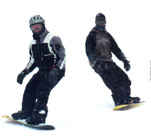THE INTERMEDIATE SNOWBOARD LESSON
by
Chuck Roberts
2. Present goal of the intermediate lesson (link skidded turns of varying shape). Remember the acronym, WWWWH: WHO - intermediate rider, WHAT-intermediate lesson, WHY-learn intermediate riding, WHERE-intermediate terrain, HOW-by explanation, demonstration, participation, practice.
3. Take students for a ride down beginner terrain to assess students' abilities.
4.Review traverse, both toe and heel side, and falling leaf both heel and toe.
5. Refine turning skills:
a) Static Exercises: Review basic stance, weight forward, hands forward, lean, press and twist to toe side (toe side skidded turn), lean, press and twist to heel side (heel side skidded turn). Dynamic Exercise: skidded turns heel side and toe side, rudder turns.
b) Practice skidded turn initiation before the fall line using the fan method. Work with forward & aft pressure distribution as well as edge to edge.
c) Perform skidded turns both heel and toe side. Correct difficulties.
d) Link skidded turns with traverse between turns. Show students how to control speed by turning more uphill. Work on "good" angles with the snow by practicing more inclination.
e) Press front foot toe and rear foot heel for toe side turns. Press front foot heel and rear foot toe for heel side turns. The resulting torsional deflection aids in turning.
6. Vary turn shape & size:
a) Ride varying intermediate terrain to introduce adaptation and observe their skill in negotiating the terrain. Shorten traverse between turns and eventually eliminate the traverse to form linked turns.
b) Introduce the concept of short and long radius turns. Introduce cross-over and cross-under movements. Static exercise: move center of mass laterally showing how upper body crosses over for long radius turns. Move board under body laterally to illustrate cross-under.
c) Introduce rhythm in the medium radius turns to maintain consistency (flow). Static exercise: sway upper body back and forth laterally to develop rhythm sensation. Dynamic exercise: establish rhythm in medium radius turns and slowly reduce turn radius while maintaining rhythm.
7. As always, get lots of mileage, practice, practice, practice. Even if the goals of the lesson are not fully realized, proper performance of intermediate goals is more desirable than poor performance of all goals.
8. Conclude lesson, review what was learned, were goals accomplished, get feedback. Tell students what to expect in the next lesson, sell the next lesson.
 BACK TO ROBERTS SKI AND SNOWBOARD INSTRUCTION HOME PAGE
BACK TO ROBERTS SKI AND SNOWBOARD INSTRUCTION HOME PAGE